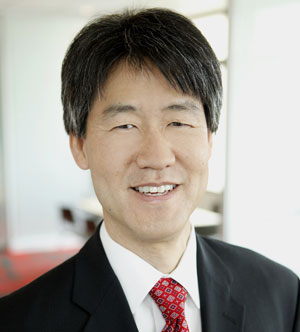As Microsoft’s new head of research Peter Lee is betting big on machines that learn in a bid to turn the company into a major player in the increasingly mobile computing universe.
“The smartphone battle isn’t over yet,” Lee insists because he knows that the mobile computing technologies that drive smartphones is becoming increasingly central to all computing.
To give Microsoft the best possible chance to win what will likely be a marathon rather than a sprint, Lee is putting his main bet on what most tech experts see as the holy grail of all computing — computers that can teach themselves how better to serve their users.
“Machine learning is the really big one,” he recently told Technology Review. “It is our number one investment. We think we’re well within reach of solving speech recognition, making a big dent in translation, and devices that see and hear with capabilities approaching human ones. So, for example, a camera could understand what is being said and what it is looking at. A photo could include this extra information. Or [a phone] could look at a plate of food and understand what it is, to help your diet and monitor your health.”
To give machines the capability to learn on their own, even superior to those possessed by their users, Lee is committed to endowing them with superhuman sensing capabilities. For example, his team devised a nine-microphone array capable of tuning into a single voice in noisy environment. That was ultimately evolved into a four-mike array that made its way into the Kinect motion-sensing controller for the Xbox360 video game console.
“Now if you use a Kinect and wave your hand, the microphone array will focus on your mouth and you can control it with speech, in a noisy environment, without yelling,” Lee explains.
Another example of Lee’s focus on machines that learn is the keypad on the Windows phone which is generally considered to be superior to those of both the iPhone and the Samsung Galaxy S line.
“The soft keyboard technology in the Windows phone… is able to learn where your fingers actually type — depending on the word, and even on the sentence,” he says. “That’s the reason why typing feels like it’s working better than it does on the iPhone.”
Another long-term research commitment Lee sees as key to Microsoft’s bid to overtake the competition is quantum computing — a field that remains largely theoretical today, with rudimentary encoding applications that stretch the concept of “quantum”.
“I predict that within five years, there will be a Nobel Prize related to quantum computing, for the basic science and physics of the ability to encode and compute using quantum effects,” Lee says. “These are becoming technologies that will be the equivalent of a transistor for a new age. And it will help with other major efforts in security and privacy.”
Lee will have to hit the mark in all those areas if Microsoft is to expand its share of the mobile operating systems market from the puny 4% it currently holds, less than a tenth of Android and about an eighth of iOS. But he’s in charge of the software giant’s immense resources which include 1,100 researchers and engineers in 13 labs around the world. The pending takeover of Nokia will add much to the company’s mobile computing resources. In his quest to secure a bigger piece of the mobile computing universe for Microsoft Lee is literally limited only by his imagination.
Lee’s official title is Corporate Vice President of Microsoft Research which puts him at the head of the software giant’s worldwide research operations. Prior to that he headed up the firm’s US research operations which comprises seven labs employing over 500 researchers, engineers and support personnel. He had joined Microsoft in 2008 as Distinguished Scientist and Managing Director of the Microsoft Research Redmond Lab.
Prior to coming to Redmond Lee worked for the US government’s highly secretive Defense Advanced Research Projects Agency (DARPA) where he founded and directed an office supporting research in computing and related areas in the social and physical sciences. While there he turned DARPA onto the power of social networks by implementing the DARPA Network Challenge in which millions of people worldwide were mobilized to hunt for red weather balloons as part of an experiment in social media and open innovation.
Before DARPA Lee headed up the nationally top-ranked computer science department at Carnegie Mellon University as well as serving as the university’s vice provost for research. At CMU he conducted research in software reliability, program analysis, security, and language design. He achieved prominence there for his role in developing proof-carrying code techniques for enhanced software security. He also worked on programming for large-scale modular robotics systems and shape analysis for C programs.
Lee has made policy contributions to the President’s Council of Advisors on Science and Technology. He is also a member of both the National Research Council’s Computer Science and Telecommunications Board and the Advisory Council of the Computer and Information Science and Engineering Directorate of the National Science Foundation.
Lee earned his BS in math and computer science from the University of Michigan at Ann Arbor before earning a PhD in computer and communication sciences from that university.


